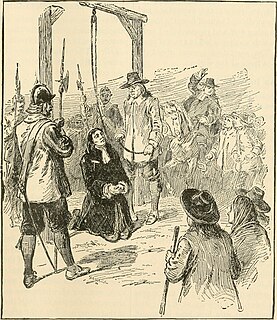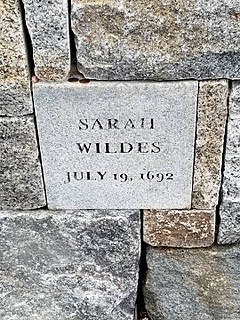
The Salem witch trials were a series of hearings and prosecutions of people accused of witchcraft in colonial Massachusetts between February 1692 and May 1693. More than two hundred people were accused. Thirty were found guilty, nineteen of whom were executed by hanging. One other man, Giles Corey, was pressed to death for refusing to plead, and at least five people died in jail.
John Proctor was a landowner in the Massachusetts Bay Colony. He was the son of John Proctor Sr. (1594–1672) and Martha Harper (1607–1667). John and his wife were tried on August 5, 1692. He was hanged on August 19, 1692 in Salem Village, Massachusetts Bay Colony during the Salem Witch Trials after being falsely accused and convicted for witchcraft.

John Hale was the Puritan pastor of Beverly, Massachusetts, and took part in the Salem witch trials in 1692. He was one of the most prominent and influential ministers associated with the witch trials, being noted as having initially supported the trials and then changing his mind and publishing a critique of them.
Elizabeth Proctor was convicted of witchcraft in the Salem Witch Trials of 1692. She was the wife of John Proctor, who was convicted and executed.

Bridget Bishop was the first person executed for witchcraft during the Salem witch trials in 1692. Nineteen were hanged, and one, Giles Corey, was pressed to death. Altogether, about 200 people were tried.

George Burroughs, was the only minister executed for witchcraft during the course of the Salem witch trials. He is best known for reciting the Lord's Prayer during his execution, something it was believed a witch could never do.

Mercy Lewis was an accuser during the Salem Witch Trials. She was born in Falmouth, Maine. Mercy Lewis, formally known as Mercy Allen, was the child of Philip Lewis and Mary (Cass) Lewis.

Rebecca Nurse was accused of witchcraft and executed in New England during the Salem Witch Trials of 1692. She was fully exonerated less than twenty years later.

Cultural depictions of the Salem witch trials abound in art, literature and popular media in the United States, from the early 19th century to the present day. The literary and dramatic depictions are discussed in Marion Gibson's Witchcraft Myths in American Culture and see also Bernard Rosenthal's Salem Story: Reading the Witch Trials of 1692
This timeline of the Salem witch trials is a quick overview of the events.
Mary Towne Eastey was a defendant in the Salem witch trials in colonial Massachusetts. She was executed by hanging in Salem in 1692.
Rev. Nicholas Noyes II was a colonial minister during the time of the Salem witch trials. He was the second minister, called the "Teacher", to Rev. John Higginson. During the Salem witch trials, Rev. Noyes served as the official minister of the trials.
Alice Parker, a resident of Salem Town, Massachusetts, was executed on September 22, 1692, during the Salem Witch Trials.

Sarah Wildes was wrongly convicted of witchcraft during the Salem witch trials and was executed by hanging. She maintained her innocence throughout the process, and was later exonerated. Her husband's first wife was a member of the Gould family, cousins of the Putnam family, the primary accusers, and court records document the family feuds which led to her persecution.
Abigail Faulkner, sometimes called Abigail Faulkner Sr., was an American woman accused of witchcraft during the Salem witch trials in 1692. In the frenzy that followed, Faulkner's sister Elizabeth (Dane) Johnson (1641-1722), her sister-in-law Deliverance Dane, two of her daughters, two of her nieces, and a nephew, would all be accused of witchcraft and arrested. Faulkner was convicted and sentenced to death, but her execution was delayed due to pregnancy. Before she gave birth, Faulkner was pardoned by the governor and released from prison.>
Sarah Cloyce was among the many accused during Salem Witch Trials including two of her older sisters Rebecca Nurse and Mary Eastey who were both executed. Sarah Cloyce was about 50-years-old at the time and was held without bail in cramped prisons for many months before her release.
Isaac Eastey was the husband of Mary Eastey, who was executed during the Salem Witch Trials of 1692. Isaac and Mary were both highly respected members of the Salem Village Church, and the community in general. Isaac played a significant role in the witch trials, which is often overlooked in history. Despite being one of the primary reasons for Mary's accusation, he desperately tried to clear his wife's name and put an end to the trials altogether.
Mary Black was a slave of African descent in the household of Nathaniel Putnam of the Putnam family who was accused of witchcraft during the Salem witch trials. Nathaniel's nephew was Thomas Putnam, one of the primary accusers, though Nathaniel himself was skeptical and even defended Rebecca Nurse. Mary was arrested, indicted, and imprisoned, but did not go to trial, and was released by proclamation on January 21, 1693 [O.S. January 11, 1692]. She returned to Nathaniel's household after she was released, another indication of Nathaniel's view of the charges against her.

Margaret Scott was found guilty of witchcraft during the Salem witch trials and was executed by hanging on September 22, 1692. She was part of the last group to be executed, which also included Mary Eastey, Martha Corey, Ann Pudeator, Samuel Wardwell, Mary Parker, Alice Parker, and Wilmot Redd. She was the only accused person from Rowley to be executed. As a lower-class, long-term widow, having lost several children in infancy, she was a prototypical witch candidate. When her husband, Benjamin, died, he left a very small estate and she, being unable to remarry, was reduced to begging, which invited resentment and suspicion. In this manner, her circumstances were comparable to fellow victim Sarah Good.








